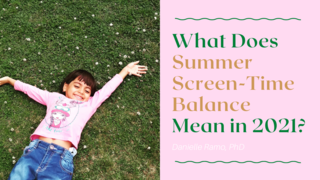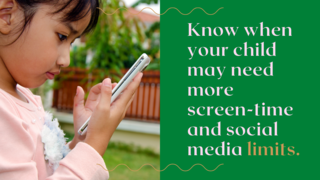Media
What Does Summer Screen-Time Balance Mean in 2021?
After a year of remote learning, try these new tech strategies with your family.
Posted April 27, 2021 Reviewed by Jessica Schrader
Key points
- The pandemic has caused what researchers have called a crisis of “digital technology overuse.”
- Social experiences online have protected adolescents against the long-term effects of isolation, suggesting that technology can also be helpful.
- Going into the summer, families can promote quality technology use as well as positive tech-free time to strike the best balance.

As we gear up for summer 2021 in our pandemic world, many of us have witnessed the inordinate amount of time our kids (and ourselves) have spent on screens. Burned out? Ready for some changes? You’re not alone.
Washington Post technology reporter Heather Kelly writes “a year of everyone turning to technology has shown us that the worth, or danger, of devices has less to do with the glowing screens themselves, and more to do with how they are used.” Her March 5 piece reflects on how a year lived online has changed our children and says what appears to matter most is “the support systems children and their parents have available to them.”
So, what can we, as parents, do? Have you ever heard the phrase, “The only way out is through”? Consider these added tips and information additions to your summer screen time support system (and try to say that three times fast!).
The effects of “digital technology overuse”
According to a review of the literature published recently in the journal Addictive Behavior Reports, the pandemic has caused an imbalance of parental care, more unguarded screen time use, and less emphasis on free play. While we are still learning a lot about the effects of “digital technology overuse,” a term researchers are using to describe the neurobiological effects and consequences of the increased technology use that’s occurred during the pandemic, we can make purposeful choices to disrupt any negative effects from continuing in our homes this summer.
The promise of social technology during COVID-19
Social development is of utmost importance during the adolescent years (ages 10 to 24), and technology has been crucial in supporting teen and young adult social lives this year. According to a 2020 article in Lancet Child & Adolescent Health, social deprivation and isolation hit adolescents especially hard and technology has likely helped protect against their widespread effects on brain and behavior during the pandemic. As we saw last summer, screens provided an outlet for our kids’ social development to continue in the midst of COVID-19 isolation. Depending on where you live, your kids may be getting a large part of their social engagement digitally—in breakout rooms through school, in private or public video game servers, and for older kids, on social media. While we await the rollout of COVID-19 vaccines for our kids, this summer means continuing to practice prevention steps recommended by the CDC to help stop the spread of COVID-19 as vaccines are distributed to everyone 16 and over.
Summer strategies to help your family balance screen time

1. Be tech-intentional by favoring quality over quantity.
I talked about this concept in my last post, 5 Ways Social Media Helps Depressed Teens Cope, which discussed findings of a national survey of teens and young adults about specific activities they do while on social media and found quality use (e.g., connecting with friends, being creative, learning, and making an impact) can help boost a young person’s ability to manage stress and work through problems—life skills needed as our kids prepare for a return to “normal” life post-pandemic. If you have young children like I do, being tech-intentional may mean watching a PBS Kids show on TV instead of a video on YouTube —known to target them with unhealthy food products. In 2019, for example, then 8-year-old Ryan Kaji of Ryan’s World earned $26 million in advertisements, sponsored posts, and product placements!

2. Put a positive frame on “no screen days.”
When I spoke recently with Dr. Michael Rich, founder and director of the Harvard Medical School / Boston Children's Hospital Digital Wellness Lab, he suggested we shift the way we talk about these “no screen days.” Why? Well, he said framing them into a positive light (e.g., “go outside day” or “family game night”) takes away the negative punishment feel of it. As a mom of three screen-loving children, I really liked this idea. Now Thursday is “family game night” at our house. In the summertime, you can also look for ways to get out of the house by revisiting shared activities like neighborhood walks after dinner, a backyard bonfire, or an RV trip to a national park. Whatever you do, just try your best to leave the Nintendo Switch at home.

3. Model the behavior you want your child to follow.
Just as it’s harder for a parent who drinks alcohol excessively to tell their teen not to drink, don’t let “do as I say not as I do” apply to your technology use. Most of us are guilty of checking our phones out of both habit and necessity to balance work and family life—especially during COVID-19. But, all this multitasking could also hurt your child's ability to learn, according to the American Academy of Pediatrics. The organization suggests keeping family mealtimes screen-free and not sleeping with your cell phone. These changes can encourage more family time, healthy summer eating habits, and better sleep. Be in the moment more. It helps when our kids see when we purposefully put down our screens, too.

4. Know when your child may need more screen time and social media limits.
Is your child’s technology use having an impact on their physical health and sleep routine? Are they continuing to find enjoyment in non-digital hobbies and social interactions with friends and family? Are you worried about their mental health? Our research at Hopelab has shown teens who struggle with depression are particularly vulnerable when they use social media while depressed and are more likely to say it makes them feel worse. For this reason, I recommend parents hold off on social media during the younger years. There is plenty of time for them to have their own YouTube channel and TikTok account later.
If you notice your child is crushed when the screen turns off and it’s happening every day, taking away the option could be particularly worthwhile (see #2). Otherwise, don’t guilt yourself about allowing it every now and then.
While there’s no perfect solution, these can help you “get through” another pandemic summer where there’s still likely to be a greater than average amount of screen time in our homes. Stay strong and keep supporting each other.
References
Alati, R., Baker, P., Betts, K. S., Connor, J. P., Little, K., Sanson, A., & Olsson, C. A. (2014). The role of parental alcohol use, parental discipline and antisocial behaviour on adolescent drinking trajectories. Drug and alcohol dependence, 134, 178–184. https://doi.org/10.1016/j.drugalcdep.2013.09.030
Alruwaily, A., Mangold, C., Greene, T., Arshonsky, J., Cassidy, O., Pomeranz, J. L., & Bragg, M. (2020). Child social media influencers and unhealthy food product placement. Pediatrics, 146(5), e20194057. https://doi.org/10.1542/peds.2019-4057
Montag, C., & Elhai, J. D. (2020). Discussing digital technology overuse in children and adolescents during the COVID-19 pandemic and beyond: On the importance of considering Affective Neuroscience Theory. Addictive behaviors reports, 12, 100313. https://doi.org/10.1016/j.abrep.2020.100313
Orben, A., Tomova, L., & Blakemore, S.-J. (2020). The effects of social deprivation on adolescent development and mental health. The Lancet Child & Adolescent Health, 4(8), 634–640. https://doi.org/10.1016/S2352-4642(20)30186-3
Rideout, V. & Fox, S. (2018). Digital Health Practices, Social Media Use, and Mental Well-Being Among Teens and Young Adults in the U.S. Hopelab & Well Being Trust. https://digitalcommons.psjhealth.org/publications/1093
Rideout, V., Fox, S., Peebles, A., & Robb, M. B. (2021). Coping with COVID-19: How young people use digital media to manage their mental health. Common Sense Media & Hopelab. www.commonsensemedia.org/coping-with-covid19


